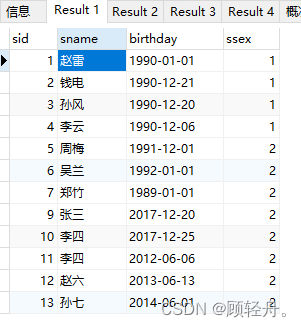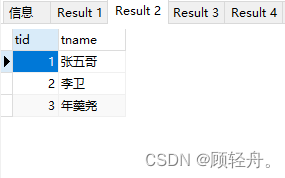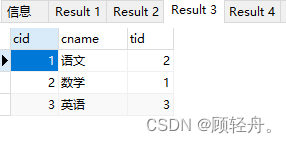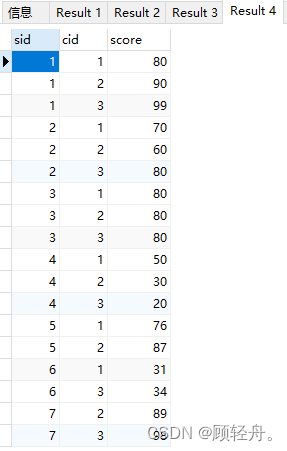Mysql数据类型与CRUD操作详细讲解
基本数据类型
整数:可选择unsigned修饰
intyint 8位 (-128 - 127)
smallint 16位 (-32768 - 32767)
mediumint 24位 (-8388608 - 8388607)
int 32位 大约正负21亿
bigint 64位
实数(带有小数点):使用标准的浮点运算进行近似计算
float 4个字节
double 8个字节
decimal 最多允许65个数字
示例:decimal(5,2),说明:5位长度,2位小数精度,如果整数部分+2位小数超长,则报错,如果只是小数部分超出2两位,则四舍五入到两位小数
字符串
char:定长:msql根据定义字符串的长度一次分配足够的空间
适用场景:较短的字符串,且所有值接近同一长度
varchar 变长字符串
- 比定长类型节约空间
- 但是ROW_FOMAT=FIXED每行使用定长
- 适用场景:字符串的最大长度比评估长度大很多,列的更新较少
- 缺点:频繁修改,且字符串的长度变化大时,可能出现页分 裂
- 不要盲目的给过大的长度
- 在临时表或排序时可能遭遇最大长度分配内存问题
Text、Blob
1.都为存放很大的数据而设计
2.与其他数据不同,都作为独立的对象存储
3.当值太大时,使用外部存储区存储,每行只要使用1-4字节存放一个指针
text存储字符数据:
- tinytext
- smalltext
- text
- mediumtext
- longtext
Blob存储二进制数据:
- tinyblob
- smallblob
- blob
- mediumblob
- longblob
日期时间
datetime
- 精度:秒
- 与时区无关,8个字节存储空间
- 范围:1001 至 9999 年
timestamp
- 保存1970年1月1日午夜以来的秒数
- 占用4个字节存储空间
- 范围:1970年 至 2038年
- 与时区有关
- 默认为NOT NULL
- 通常尽量使用timestamp
- 精度:秒
date
- yyyy-MM-dd
time
- HH:mm:ss
选择标识符
- 用来进行关联操作
- 在其他表中作为外键
- 整型通常是标识列的最好选择
- 相关的表中使用相同的数据类型
- 尽量避免字符串作为标识列,尤其是随机生成的字符串,(如:uuid)导致insert与select都很慢
- 插入值被随机写到索引的不同位置,insert慢,容易导致页分 裂,磁盘随机读取
- 逻辑上相邻的行被分布在磁盘和内存的不同地方,select慢
- 使mysql查询缓存失效
- 如果需要存储uuid,则应将“-”去除
(插入值被随机写到索引的不同位置,insert慢,容易导致页分 裂,磁盘随机读取
逻辑上相邻的行被分布在磁盘和内存的不同地方,select慢 使mysql查询缓存失效 如果需要存储uuid,则应将“-”去除)
数据库命令
创建数据库:
?| 1 2 3 4 5 6 7 | create database 数据库名 create database if not exists 数据库名 default charset utf8 collate utf8_general_ci; //默认的数据库编码集:utf8 // collate 表示校验规则为utf8_general_ci //常用排序类型 //utf8_general_cs(区分大小写) //utf8_genera_ci(不区分大小写) |
查看所有数据库:
show databases
删除数据库:
drop database 数据库名
注意:删除数据库是一个危险操作,如要删除建议先备份
建表与约束
建表
命令格式:
create table 表名称(
列名称1 数据类型not null,
列名称2 数据类型,
列名称3 数据类型,
unique(列名称1[,列名称2,...,列名称N])
)
示例:
?| 1 2 3 4 5 6 7 8 9 10 | create table t_student ( sid int not null comment '学号' , sname varchar (60) not null comment '姓名' , sex tinyint not null default 1 comment '性别:1男, 2女' , age tinyint not null comment ' 年龄' , icard varchar (18) not null comment '身份证,唯一约束' , primary key (sid), unique key AK_Key_2 (icard) ) comment '学生信息表' ; |
约束
主键约束:
primarykey
增加主键(alter table 表名 add primary key(主键名称))
删除主键(alerttable 表名dropprimarykey) 非空约束:
?| 1 | sid int not null comment '学号' , |
外键约束:
?| 1 2 3 4 5 6 7 8 9 10 11 | create table t_score ( id int not null comment '记录流水号' , sid int not null comment '学号' , cid int not null comment '课程ID' , score float comment '成绩' , primary key (id), foreign key (sid) references t_student (sid) on delete restrict on update redtrict , unique key ak_key_2(sid, cid) ); //说明: sid为本表的外键,关联t_student表中的的sid主键, on delete restrict on update redtrict说明在本表有数据的情况下,主表的关联键不能删除或更新。 |
增加主键(alerttable 表名 add foreign key(外键名称) references 主表名称(主键名称))
删除主键(alerttable 表名drop foreign key约束名)
唯一约束:uniquekey约束名 (字段)
创建唯一约束:alert table 表名 add unique(列名称1[,列名称2,..])
create unique index UserNameIndex on 't_user' ('username')
删除唯一约束:alerttable 表名dropindex 唯一约束缩影名称
默认值约束:default
基本数据操作(CRUD)
数据准备
?| 1 2 3 4 5 6 7 8 9 10 11 12 13 14 15 16 17 18 19 20 21 22 23 24 25 26 27 28 29 30 31 32 33 34 35 36 37 38 39 40 41 42 43 44 45 46 47 48 49 50 51 52 53 54 55 56 57 58 59 60 61 62 63 64 65 66 67 68 69 70 71 72 73 74 75 76 77 78 | create database db_t281 use db_t281 -- 1.学生表-t_student -- sid 学生编号,sname 学生姓名,sage 学生年龄,ssex 学生性别 create table t_student ( sid int not null auto_increment comment '学号' , sname varchar (40) not null comment '名称' , birthday date not null comment '年龄' , ssex tinyint not null default 1 comment '1男,2女' , primary key (sid) ); INSERT INTO t_student VALUES (1, '赵雷' , '1990-01-01' , 1); INSERT INTO t_student VALUES (2 , '钱电' , '1990-12-21' , 1); INSERT INTO t_student VALUES (3 , '孙风' , '1990-12-20' , 1); INSERT INTO t_student VALUES (4 , '李云' , '1990-12-06' , 1); INSERT INTO t_student VALUES (5 , '周梅' , '1991-12-01' , 2); INSERT INTO t_student VALUES (6 , '吴兰' , '1992-01-01' , 2); INSERT INTO t_student VALUES (7 , '郑竹' , '1989-01-01' , 2); INSERT INTO t_student VALUES (9 , '张三' , '2017-12-20' , 2); INSERT INTO t_student VALUES (10 , '李四' , '2017-12-25' , 2); INSERT INTO t_student VALUES (11 , '李四' , '2012-06-06' , 2); INSERT INTO t_student VALUES (12 , '赵六' , '2013-06-13' , 2); INSERT INTO t_student VALUES (13 , '孙七' , '2014-06-01' , 2); -- 2.教师表-t_teacher -- tid 教师编号,tname 教师名称 CREATE TABLE t_teacher ( tid INT NOT NULL AUTO_INCREMENT COMMENT '教师ID' , tname VARCHAR (40) NOT NULL COMMENT '教师名称' , PRIMARY KEY (tid) ); INSERT INTO t_teacher VALUES (1 , '张五哥' ); INSERT INTO t_teacher VALUES (2 , '李卫' ); INSERT INTO t_teacher VALUES (3 , '年羹尧' ); -- 3.课程表-t_course -- cid 课程编号,cname 课程名称,tid 教师名称 CREATE TABLE t_course ( cid INT NOT NULL COMMENT '课程ID' , cname VARCHAR (50) COMMENT '课程名称' , tid INT COMMENT '教师id' , PRIMARY KEY (cid) ); INSERT INTO t_course VALUES (1 , '语文' , 2); INSERT INTO t_course VALUES (2 , '数学' , 1); INSERT INTO t_course VALUES (3 , '英语' , 3); -- 4.成绩表-t_score -- sid 学生编号,cid 课程编号,score 成绩 CREATE TABLE t_score ( sid INT NOT NULL COMMENT '学号,外键' , cid INT NOT NULL COMMENT '课程id' , score decimal (5,2) COMMENT '成绩' , UNIQUE KEY ak_key_sid_cid (sid, cid) ); INSERT INTO t_score VALUES (1 , 1 , 80); INSERT INTO t_score VALUES (1 , 2 , 90); INSERT INTO t_score VALUES (1 , 3 , 99); INSERT INTO t_score VALUES (2 , 1 , 70); INSERT INTO t_score VALUES (2 , 2 , 60); INSERT INTO t_score VALUES (2 , 3 , 80); INSERT INTO t_score VALUES (3 , 1 , 80); INSERT INTO t_score VALUES (3 , 2 , 80); INSERT INTO t_score VALUES (3 , 3 , 80); INSERT INTO t_score VALUES (4 , 1 , 50); INSERT INTO t_score VALUES (4 , 2 , 30); INSERT INTO t_score VALUES (4 , 3 , 20); INSERT INTO t_score VALUES (5 , 1 , 76); INSERT INTO t_score VALUES (5 , 2 , 87); INSERT INTO t_score VALUES (6 , 1 , 31); INSERT INTO t_score VALUES (6 , 3 , 34); INSERT INTO t_score VALUES (7 , 2 , 89); INSERT INTO t_score VALUES (7 , 3 , 98); select * from t_student; select * from t_teacher; select * from t_course; select * from t_score; |
数据表如下:
t_student学生表 t_teacher教师表


t_course课程表 t_score成绩表


1)查询" 1 "课程比" 2 "课程成绩高的学生的信息及课程分数
?| 1 2 3 4 5 | SELECT stu.sid,stu.sname,stu.ssex,c1.cid, c1.score, c2.cid, c2.score FROM t_student stu INNER JOIN ( SELECT t1.sid, t1.cid, t1.score FROM t_score t1 WHERE t1.cid = 1 ) c1 ON stu.sid = c1.sid INNER JOIN ( SELECT t2.sid, t2.cid, t2.score FROM t_score t2 WHERE t2.cid = 2) c2 ON stu.sid = c2.sid WHERE c1.score > c2.score |
2)查询同时选修" 1 "课程和" 2 "课程的学生信息
?| 1 2 3 4 5 6 7 8 9 10 11 12 | //方法一 SELECT stu.sid,stu.sname,stu.ssex,c1.cid, c1.score, c2.cid, c2.score FROM t_student stu INNER JOIN ( SELECT t1.sid, t1.cid, t1.score FROM t_score t1 WHERE t1.cid = 1 ) c1 ON stu.sid = c1.sid INNER JOIN ( SELECT t2.sid, t2.cid, t2.score FROM t_score t2 WHERE t2.cid = 2) c2 ON stu.sid = c2.sid //方法二 SELECT stu.`sid`,stu.`sname`, stu.`ssex`, tmp.c1num, tmp.c2num FROM t_student stu INNER JOIN ( SELECT t.`sid`, SUM ( CASE WHEN t.cid = 1 THEN t.`score` ELSE 0 END ) c1num, SUM ( CASE WHEN t.cid = 2 THEN t.`score` ELSE 0 END ) c2num FROM t_score t GROUP BY t.`sid` ) tmp ON stu.sid = tmp.sid AND tmp.c1num > 0 AND tmp.c2num > 0; |
3)查询选修" 1 "课程但没有选修" 2 "课程的情况
?| 1 2 3 4 5 6 7 8 9 | SELECT stu.* FROM t_student stu WHERE stu.sid IN ( SELECT t1.sid FROM t_score t1 WHERE t1.cid = 1) AND stu.sid NOT IN ( SELECT t1.sid FROM t_score t1 WHERE t1.cid = 2) SELECT stu.`sid`,stu.`sname`, stu.`ssex`, tmp.c1num, tmp.c2num FROM t_student stu INNER JOIN ( SELECT t.`sid`, SUM ( CASE WHEN t.cid = 1 THEN t.`score` ELSE 0 END ) c1num, SUM ( CASE WHEN t.cid = 2 THEN t.`score` ELSE 0 END ) c2num FROM t_score t GROUP BY t.`sid` ) tmp ON stu.sid = tmp.sid AND tmp.c1num > 0 AND tmp.c2num = 0; |
4)查询不存在" 1 "课程但存在" 2 "课程的情况
?| 1 2 3 | SELECT t1.sid,t1.cid,t1.score FROM t_score t1 WHERE t1.cid = 2 AND t1.sid NOT IN ( SELECT t2.sid FROM t_score t2 WHERE t2.cid = 1); |
查询各科成绩最高分、最低分和平均分:
1)显示列:课程ID,课程名称,最高分,最低分,平均分,选修人数,及格率,中等率,优良率 2)优秀率及格为>=60,中等为:70-80,优良为:80-90,优秀为:>=90 3)要求查询结果按人数降序排列,若人数相同,按课程号升序排列
?| 1 2 3 4 5 6 7 8 9 10 11 12 13 14 | SELECT t2.cid '课程ID' , t2.cname '课程名称' , MAX (t1.score) '最高分' , MIN (t1.score) '最低分' , ROUND( AVG (t1.score), 2) '平均分' , COUNT (t1.sid) '选修人数' , ROUND( SUM ( CASE WHEN t1.score >= 60 THEN 1 ELSE 0 END ) / COUNT (t1.sid), 2) '及格率' , ROUND( SUM ( CASE WHEN t1.score >=70 AND t1.score < 80 THEN 1 ELSE 0 END )/ COUNT (t1.sid),2) '中等率' , ROUND( SUM ( CASE WHEN t1.score >=80 AND t1.score < 90 THEN 1 ELSE 0 END )/ COUNT (t1.sid),2) '优良率' , ROUND( SUM ( CASE WHEN t1.score >= 90 THEN 1 ELSE 0 END )/ COUNT (t1.sid), 2) '优秀率' FROM t_score t1 INNER JOIN t_course t2 ON t1.cid = t2.cid GROUP BY t2.cid, t2.cname ORDER BY COUNT (t1.sid) DESC , t2.cid ASC ; |
到此这篇关于Mysql数据类型与CRUD的文章就介绍到这了,更多相关Mysql数据类型内容请搜索服务器之家以前的文章或继续浏览下面的相关文章希望大家以后多多支持服务器之家!
原文链接:https://blog.csdn.net/qq_64001795/article/details/125939431
1.本站遵循行业规范,任何转载的稿件都会明确标注作者和来源;2.本站的原创文章,请转载时务必注明文章作者和来源,不尊重原创的行为我们将追究责任;3.作者投稿可能会经我们编辑修改或补充。











